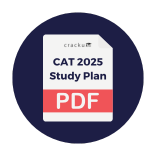Answer questions on the basis of information given in the following case.
Bright Engineering College (BEC) has listed 20 elective courses for the next term and students have to choose any 7 of them. Simran, a student of BEC, notices that there are three categories of electives: Job - oriented (J), Quantitative - oriented (Q) and Grade - oriented (G). Among these 20 electives, some electives are both Job and Grade - oriented but are not Quantitative - oriented (JG type). QJ type electives are both job and Quantitative - oriented but are not Grade - oriented and QG type electives are both Quantitative and Grade - oriented but are not Job - oriented. Simran also notes that the total number of QJ type electives is 2 less than QG type electives. Similarly, the total number of QG type electives is 2 less than JG type and there is only 1 common elective (JQG) across three categories. Furthermore, the number of only Quantitative - oriented electives is same as only Job - oriented electives, but less than the number of only Grade - oriented electives. Each elective has at least one registration and there is at least one elective in each category, or combinations of categories.
On her way back Simran met her friend Raj and shared the above information. Raj is preparing for XAT and is only interested in Grade - oriented (G) electives. He wanted to know the number of G - type electives being offered. Simran replied, “You have all the information. Calculate the number of G - type electives yourself. It would help your XAT preparation”. Raj calculates correctly and says that there can be _______ possible answers. Which of the following options would b est fit the blank above?
Simran prefers J - type electives and wants to avoid Q - type electives. She noted that the number of only J - type electives is 3. Raj’s preference is G - type electives followed by Q - type electives. However, they want to take as many common electives as possible. What is the maximum number of electives that can be common between them, without compromising their preferences?
Vijay and Raj want to avoid each other. Vijay is interested in J - type electives and wants to avoid Q - type electives. Raj’s preference is G - type electives followed by Q - type electives. Raj noted that the number of only G - type electives is 2. Is there a possibility that they would not share any common electives(s)?
Answer questions on the basis of information given in the following case.
Mr. Dipangshu Barua, a young IT professional, came early to office to assist his boss in the preparation for an important client presentation. When be switched on his computer, he saw an email from Mr. Patel. The email was as follows:
Dear Mr. Barua,
This email serves as a follow - up of my conversation with you on December 1, 2014. I have already conveyed need for improvement in your behaviour as desired as desired by your project leader and colleagues. They are yet to notice any visible improvements. I am apprehensive that your failure to act may warrant further action leading to dismissal. I will continue to monitor and assess your performance over the next three months to determine whether improvements meet the expectations. At the same time, I would like to re - affirm that you are very valuable for our organization.
Best Wishes,
Mr. A. Patel
HR Director
Initially, the e - mail distracted Dipangshu but he decided to focus on the job. Which of the following options might best explain his decision to do so?
The scheduled presentation went off smoothly. Back in his cabin, Dipangshu read Mr. Patel’s e - mail once more and pondered over it. During the last meeting he tried hard to put forward his explanation but Mr. Patel had not allowed him to speak. Dipangshu was thinking of meeting Mr. Patel once again but was doubtful that would help. Incidentally, he had a job offer from a start - up with a comparable salary. If Dipangshu was to join the new job, he had to accept the offer within the next two weeks. However, he cannot think of a life without a job. Dipangshu was confused!
Which of the following options would be the best move for Dipangshu?
After a couple of weeks, Mr. Patel came to know that Dipangshu’s project leader Mr. John, a very competent senior executive, may have wil fully influenced his team members to file a wrong complaint against Dipangshu. Mr. John may have done it because Dipangshu has refused to tow John’s line. Mr. Patel also came to know that Dipangshu was thinking of quitting this job. He felt regretful about his letter to Dipangshu. He wanted to resolve the complicated situation. He was contemplating following five actions in his mind.
I. Talk to Mr. John about Dipangshu and convey to him that losing a bright employee would cost the organization dearly.
II. Catch up with Mr. John during coffee break and convey that Dipangshu has a very good track record.
III. Chat with Dipangshu during coffee break.
IV. Catch up with Dipangshu during coffee break and convey that the organization values him.
V. Arrange a meeting among Mr. John, Dipangshu and himself to sort out the difference.
Which of the following is the best sequence of actions for resolving the problem?


.png)

